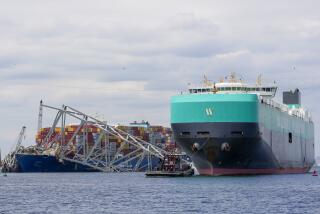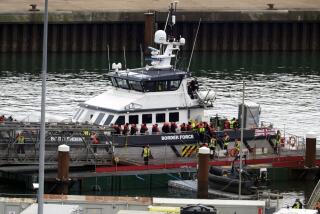Britain to Probe Ferry Tragedy
ZEEBRUGGE, Belgium â The British government announced Monday that it will launch a thorough inquiry into the sinking of the ferry that capsized here Friday night with the apparent loss of 134 lives.
Transport Minister John Moore said all such ferries will be thoroughly checked and that orders will be issued forbidding ships to leave port with their bow doors open.
However, the British official said there was no evident design fault on which to blame the disaster, and he is not restricting operations of similar ferries plying the busy route.
The investigating committee looking into the disaster, the worst peacetime accident ever in the waters between Britain and the Continent, consists of a five-member panel headed by an admiralty judge.
Fund for Victimsâ Families
The British government announced that it is setting up a fund of about $1.5 million for families of the victims. The ferry company said it is setting aside about $390,000 as a fund for the benefit of survivors and the victimsâ families.
The car and passenger ferry, the Herald of Free Enterprise, mysteriously flooded and keeled over minutes after starting a scheduled voyage to the English port of Dover with 543 passengers and crew members on board.
Officials have said there are now 53 confirmed dead and 81 missing and believed dead. Of the 53 bodies brought ashore, 34 have been positively identified by relatives. According to the officials, one person who had been counted as missing was in fact rescued and had returned to England.
Salvage operations began in earnest Monday on the 8,000-ton vessel, which now lies on its side on a sand bank just outside the jutting entrance of Zeebrugge harbor.
Preliminary reports from this Belgian port suggested that sea water flooded in through open bow doors of the ferry as the vessel cleared the harbor.
Ballast Theory
Several maritime experts here suggested that the vessel had been ballasted with water in the forward tanks, causing its bow to ride lower and allowing seawater into the ship--if the doors were open.
Once enough water had flowed into the long vehicle decks, which are not compartmentalized, the ship then would have listed and capsized in a matter of minutes--which appeared to be the case Friday night, marine specialists said.
In Zeebrugge on Monday, Peter Ford, chairman of the ferry company, Townsend Thoresen, said he had seen the vesselâs captain, David Lewry, in the hospital here but, because of the captainâs injuries--he is recovering from shock and a punctured lung--had not discussed with him the cause of the disaster.
As salvage operations began, Ford said the chief priority was to retrieve the bodies of the 81 passengers and crew members still missing.
He said that if âgood luck and good weatherâ persist, the righting of the vessel by a Dutch salvage firm might be accomplished within two weeks. However, he added, it might take as long as four or five weeks.
At noon Monday in this Belgian port city, an interdenominational memorial service was said at the local Roman Catholic church by the bishop of Bruges, Msgr. Roger Vangheluwe, in whose diocese the port lies, and attended by the Rt. Rev. Richard Third, Anglican bishop of Dover.
In England, a truck driver named Ian Calderwood, who had survived the sinking, said that shortly after the ferry left the dock, he noticed crew members trying to close the bow doors with sledgehammers. This gave added credence to the theory that somehow the bow doors had not closed properly, allowing seawater in.
There were reports in British papers that the assistant boatswain, Marc Stanley, exclaimed from his hospital bed here: âOh God, did I leave the door open? Did I kill all those people?â However, officials would not confirm the reports.
Transport Minister Moore was one of many officials paying tribute Monday to the rescue effort, which seemed a model of international cooperation.
During the operation, conducted at night and in 40-degree water, 409 people were pulled from inside the stricken vessel or the North Sea waters around it.
Late Monday, some of the details of the rescue--impressive in its professionalism and rapidity--came to light.
On Friday night, the Belgian navy was embarked on a North Atlantic Treaty Organization exercise code-named Wintex, with many officers and enlisted men on duty throughout the night. So when the Zeebrugge naval base received the first flash on the capsizing, experienced hands were available. The NATO operation was canceled, and helicopters and naval vessels were ordered to speed to the harbor.
Emergency Plans Made
As it happened, for the last couple of years the local government of West Flanders had been preparing contingency plans for action in the case of an emergency involving the port--it is one of Belgiumâs busiest, with volatile natural gas and petroleum products being unloaded and stored here.
Meanwhile, in nearby Bruges, the provincial capital, St. Johns Hospital had developed its own catastrophe plan, set up to respond to a major disaster in the province.
So when the survivors from the Herald of Free Enterprise began landing by helicopter and boat at the naval base, scores of ambulances with disaster-trained nurses and Red Cross workers were already lined up ready to receive them.
More to Read
Sign up for Essential California
The most important California stories and recommendations in your inbox every morning.
You may occasionally receive promotional content from the Los Angeles Times.










